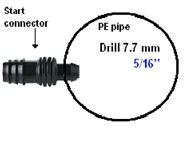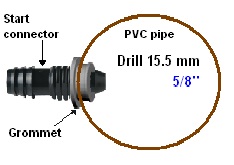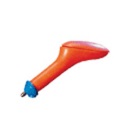How To Install Drip Irrigation Pipes
Drip irrigation systems installation guide. 7. Covering main lines ditches viii. Manifold lines, ditches excavation 9. Manifold lines, pipes placement, union and lateral outlets preparation. 10. Drip irrigation (mini sprinklers) laterals distribution. 11. Covering manifold lines ditches 12. Main lines flushing and testing. thirteen. Manifold lines flushing and testing. 14. Emitters insertion and placement. 15. Laterals flushing and testing, emitters inspection. 16. Irrigation shifts menstruum rates measurement inspection. one. Marker pipe lines and intersections Delight be certain that all crop lots are marked or at least clear to y'all, as well water source location etc. The offset step in drip irrigation installation, prior to any activeness should be verification and comparison of the irrigation design / program to the bodily field , crops and water source geometrical and topographic dimensions and quantities. Good practice is to count trees or to sum all sub plots areas. Endeavor to pick at least 4 topographical points in the field to compare the tiptop to that of betoken with the same point on the plan. * A good practice in large irrigation systems installations is to attach the plan to plywood and to embrace information technology with plastic sheet (mulch), that way you will e'er accept it set up to use in the field itself. two. Main lines ditches excavation Excavate all primary lines with the appropriate depth and width. Depth should accept in business relationship futurity field works depth and other projects that might cross those pipelines. Mutual minimum recommended measurements Pipe diameter (mm) Ditch Depth Ditch Width (m) 63 0.4 to 0.6 0.ii 75 0.45 to 0.65 0.25 xc 0.vi to 0.8 0.35 110 0.75 to 0.95 0.4 140 0.eight to one.0 0.45 160 0.85 to 1.05 0.v 225 0.nine to 1.1 0.55 280 0.95 to i.15 0.6 3. Assembling irrigation control and distribution heads. You might want get together all control heads and even the main head in advance. Using the advisable dealing materials equally Teflon record and special seals where needed. Be sure to assemble each head according to the head drawings of the specific organization pattern. Nosotros recommend yous volition number each head and mark the aforementioned number on the general assembly plan. This work tin can be done in field or in another out of field place. 4. Main lines piping placement and marriage. Place the piping (rolls or trams) along the open up ditches, be sure that the ditches are clean of sharp large stones that can impairment the pipes. Than place the pipes one by i into the ditch while unioning each tram to the side by side one using the appropriate method: Compression fittings for HDPE, solvent Welding (Gum for PVC pipes or PVC bong shape heads with rubber seals. For HDPE pinch pipes delight see the following links: For PVC solvent welding joints pipes and fittings (glue) delight run across the post-obit link: For PVC bell / rubber joints pipes and fittings, delight run into the following link: 5. Connections betwixt main lines with control and distribution heads. When primary lines are connected, before covering the ditches (about all system junctions) Connect each command head, bypass, valves head, filtration, water metering and fertigation heads. All heads should exist erected and supported (if needed) properly to avoid failures and parts amercement. vi. Main lines ends and intersections and anchoring. When using PVC pipes and joints with bell/rubber joints a solid strong anchoring block is needed in pismire line start, end, elbow, tee etc. The cement block volition prevent from the bell/rubber joints to be pulled out one from another whenever the system is under pressure. The most common anchoring is made bt cement fabricated at the field of the project. Cement block size and position should be calculated by a professional engineer appropriately. 7. Covering chief lines ditches When all pipes and control heads are assembled a complete coverage of the various ditches should exist washed. Compacting of the covered soil should be done if needed as well. Excavate manifold lines with the appropriate depth and width. Depth should accept in account future field works depth and other projects that might cross those pipelines. Common minimum recommended measurements Piping diameter (mm) Ditch Depth Ditch Depth 32 to 63 0.xv to 0.3 0.4 to 0.6 75 to 90 0.2 to 0.35 0.45 to 0.65 9. Manifold lines, pipes placement, marriage and lateral outlets grooming. Connections from manifold lines to drip lateral are washed with 2 primary methods. A. Caput connectors that start from PE or PVC pipes (32 mm to ninety mm) Usually bachelor sizes: 12, xvi, 17 and twenty mm For PE HDPE pipage use a seven.7 mm drill For PVC pipe apply a 15.5 mm drill When using clamp saddles along with threaded barbed connectors Locate each clamp saddle in the center of the target drip lateral; brand certain that the O-ring is placed in its groove appropriately. Tighten the bolts. (usually 2 or four bolts) Than drill a pigsty in a diameter according to the saddle manufacturer instructions. Usuall the hle should be smaller than the O-ring located between the saddle and the pipe. Common hole bore for ¾" outlet saddle is a sixteen to 19 mm 10. Baste irrigation (mini sprinklers) laterals distribution. Distribute drip or mini sprinklers laterals forth the crop lines, spaced according to the organisation design. Connect each lateral to the manifold pipage with the advisable connector. Available connectors are barbed (toothed) connectors for LDPE laterals or Ring assisted connectors for tapes and LDPE with small wall thickness. Sometimes mainly in orchards or other landscape projects compression connectors are existence used. Check the list of materials to figure out which connector is planned for this projection. When all manifold pipes and lateral are assembled, a complete coverage of the various ditches should be done. Compacting of the covered soil should be done if needed likewise. 12. Master lines flushing and testing. Flush the cease of each main line and exam each main line to assure a perfect installation Affluent the end of each manifold line and examination each manifold line to assure a perfect installation 14. Emitters insertion and placement. If laterals are pre made go to number 15. If online (button etc.) drippers or mini sprinklers are to be used, you should perforate holes in the laterals in the appropriate location and spacing according to your system design. Holes are existence done with manual punchers. Punch tool Quick Punch tool Puncher diameter is subject to the dripper / mini sprinkler manufacturer specific instructions. Mini Sprinklers 4/7 mm connectors = 3.0 mm fifteen. Laterals flushing and testing, emitters inspection. Before you can open water to use finally the system for irrigation you should affluent again all manifold lines and and then all lateral lines, when h2o is articulate and all laterals are flushed you can shut each lateral finish with the appropriate line terminate. Line stop for LDPE pipe Cease line for tape and sparse wall pipes Inspect each lateral and each emitter to assure it is working properly with the designed menstruation rate without lateral leaks. Start the installation shifts i by one inspecting the working pressure, menstruation rates, wetting zones etc. Good luck
1. Marking pipage lines and intersections
2. Main lines ditches digging
3. Assembling irrigation control and distribution heads.
4. Main lines piping placement and spousal relationship.
5. Connections between principal lines with control and distribution heads.
6. Main lines ends and intersections and anchoring.
Commencement marker all the pipe lines and intersections, according to the updated drip irrigation projection plan. That pace should be done past the projection managing director itself, sometimes with the help of a professional person surveyor. The best way is to marc the end points of each line with wood stakes, using a rope to spread lime powder along the lines with the aid of a rope. In every intersection it is recommended to stick a bigger stake with the intersection number and ditch depth and width dimensions.
for principal pipe lines installation
(m)
Compression fittings installation instructions, xvi to 75 mm
or
Compression fittings installation instructions, 90 and 110 mm
PVC Solvent Welding joints (Glue)
viii. Manifold lines, ditches digging
for manifold pipe lines installation
Seasonal field crops (grand)
Orchards (m)
Than connect direct pushing each connector with force using a short screwdriver. 
Besides you should use a special grommet to assure sealing.
Afterwards drilling, identify the grommet in the hole and then connect the beginning connector by pushing it with force using a curt screwdriver. 
B. Clamp Saddles,

eleven. Covering manifold lines ditches
13. Manifold lines flushing and testing.


Common holes:
Supertif and D1000 Online Drippers = 2.0 mm
Katif Dripper = 2.8 mm


16. Irrigation shifts flow rates measurement inspection.
When installation is washed clean the main and control (if whatever) filters.
world wide web.irrigationglobal.com
Irrigation global.com is offer also Irrigation pattern services and Irrigation Projects Execution.
Source: https://www.irrigationglobal.com/contents/en-us/d182_drip_irrigation_sytems_installation.html
Posted by: georgetheaking.blogspot.com


0 Response to "How To Install Drip Irrigation Pipes"
Post a Comment